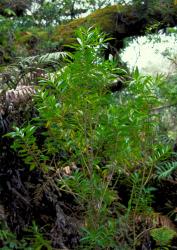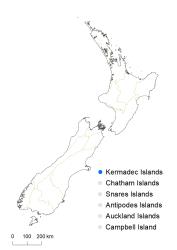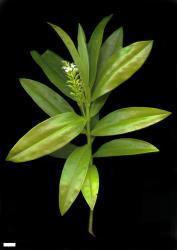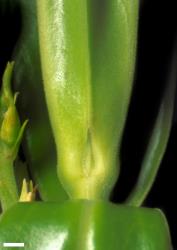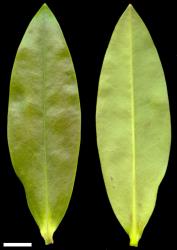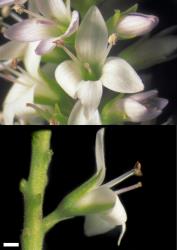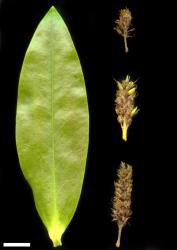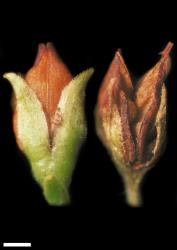- ≡ Hebe breviracemosa (W.R.B.Oliv.) Andersen, Trans. New Zealand Inst. 56: 693 (1926)
Openly branched, bushy shrub to 2 m tall. Stems erect, eglandular-puberulent; hairs uniform. Leaf bud distinct, its leaves appressed at margins until fully grown; sinus narrowly acute. Leaves opposite-decussate, erecto-patent to recurved; lamina thin to sub-coriaceous, narrowly elliptic to elliptic to obovate or oblanceolate, 23–112 mm long, 9–26 mm wide, glossy green above, dull pale green beneath; midrib and secondary veins evident; surfaces hairy along midrib above and often beneath and minutely glandular-hairy beneath; margin ciliolate to glabrous, entire; apex sub-acute to acute; base cuneate; petiole indistinct, 1.5–3.0 mm long. Inflorescence a lateral raceme, 25–50 mm long; flowers crowded, 19–45, all bisexual; bracts alternate, lanceolate to narrowly deltoid, usually > or sometimes = pedicels; pedicels erecto-patent, 1–3 mm long, eglandular-pubescent all around. Calyx lobes 4, narrowly acute to acuminate, 3–5 mm long, sub-equal, mixed glandular- and eglandular-ciliate and sometimes sparsely eglandular-hairy outside. Corolla 7–9 mm diameter; tube white, 1.3–2.3 mm long, < calyx, eglandular-hairy inside and out; lobes 4, white or tinged pale purplish, erecto-patent to recurved, sub-equal, elliptic to ovate, 3.5–4.0 mm long, sub-acute to acute; nectar guides absent. Stamen filaments white, 2.4–3.0 mm long; anthers purplish. Style glabrous, 2.4–4.0 mm long. Capsules latiseptate, acute to acuminate, glabrous, 2.5–5.0 mm long, 2–3 mm at widest point. Seeds broadly ellipsoid or discoid, flattened, smooth, straw-yellow to brown, 0.7–1.0 mm long.
V. breviracemosa is the only woody Veronica known from Raoul I.
V. breviracemosa plants are superficially similar to V. stricta, but V. stricta is clearly distinguished by the absence of a leaf bud sinus, the longer inflorescences of smaller and usually more numerous flowers, which have longer corolla tubes, narrow erect to sub-erect corolla lobes, and longer filaments and styles.
Kermadec Is. (Raoul I. only). At one time it was thought to be extinct, but since its rediscovery in 1983 the population has recovered following removal of goats from the island.
Open places in forest, especially on cliffs. Recorded elevations range from 30 to 300 m.
Flowers: January–July; fruits: February–August (probably persisting longer).
2n = 40 (see Bayly & Kellow 2006, as Hebe breviracemosa).
Veronica breviracemosa is classified in V. subg. Pseudoveronica sect. Hebe and the informal group “Apertae” (large-leaved) (Albach & Meudt 2010; Bayly & Kellow 2006).
Although a narrow leaf bud sinus is visible at least in fresh specimens, the leaf narrows gradually to the petiole with only a very obscure transition. In addition, hairs are often dense towards the base of the margin and along the petiole and can obscure the sinus.



